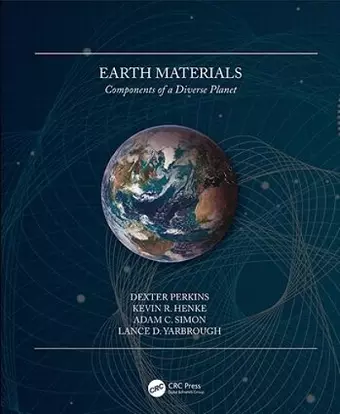Earth Materials
Components of a Diverse Planet
Dexter Perkins author Adam Simon author Kevin Henke author Lance Yarbrough author
Format:Hardback
Publisher:Taylor & Francis Ltd
Published:7th Aug '19
Currently unavailable, and unfortunately no date known when it will be back
This hardback is available in another edition too:
- Paperback£76.99(9780367185947)

There is a large and growing need for a textbook that can form the basis for integrated classes that look at minerals, rocks, and other Earth materials. Despite the need, no high-quality book is available for such a course. Earth Materials is a wide-ranging undergraduate textbook that covers all the most important kinds of (inorganic) Earth materials. Besides traditional chapters on minerals and rocks, this book features chapters on sediments and stratigraphy, weathering and soils, water and the hydrosphere, and mineral and energy deposits. Introductions to soil mechanics and rock mechanics are also included.
This book steers away from the model of traditional encyclopedic science textbooks, but rather exposes students to the key and most exciting ideas and information, with an emphasis on thinking about Earth as a system. The book is written in such a manner as to support inquiry, discovery and other forms of active learning. All chapters start with a short topical story or vignette, and the plentiful photographs and other graphics are integrated completely with the text.
Earth Materials will be interesting and useful for a wide range of learners, including geoscience students, students taking mineralogy and petrology courses, engineers, and anyone interested in learning more about the Earth as a system.
The geologists who wrote this textbook, including Perkins (Univ. of North Dakota) and three coauthors, have adopted a broader focus on earth materials than is usual in geology texts, where emphasis is frequently limited to inorganic material. Beyond the expected chapters on rock classification and crystallography, these authors also highlight the various systems that affect earth materials, such as tectonics, hydrology, and erosion, including the results of weathering. Readers will even find chapters on human-influenced geology, as demonstrated in the energy and engineering sectors by such activities as fracking and mining. This unusual breadth of material allows for context and relationships to be featured, but also results in the fact that no particular topic is treated in great depth. Written to engage introductory-level readers, the text is structured so that each chapter begins with an interesting narrative or famous example of the subject at hand and concludes with review questions. Nearly every page features at least one photographic image, figure, or graph in support of the text to demonstrate the concepts covered in the text. Advanced researchers will prefer books that focus on a narrower range of topics but in more detail. Novices will appreciate the conversational style adopted here, along with the relatively short narratives and frequent illustrations.
Summing Up: Recommended. Lower-division undergraduates. General readers.
J.M. Cook (University of West Georgia) in CHOICE, July 2020 Vol. 57, No. 11
ISBN: 9780367145651
Dimensions: unknown
Weight: 453g
556 pages